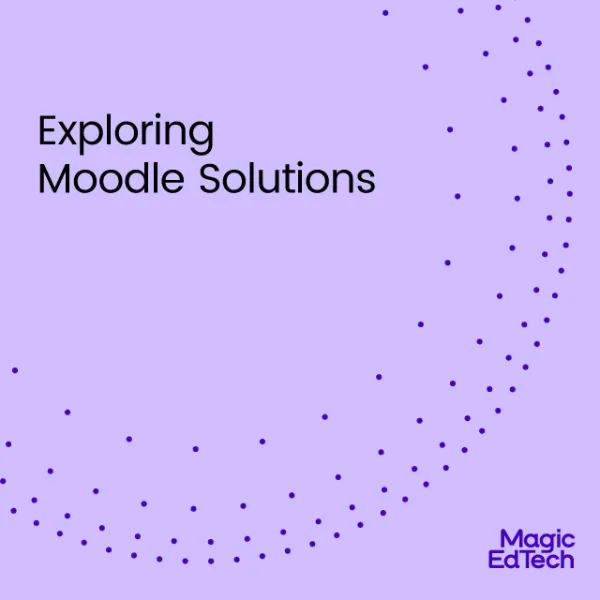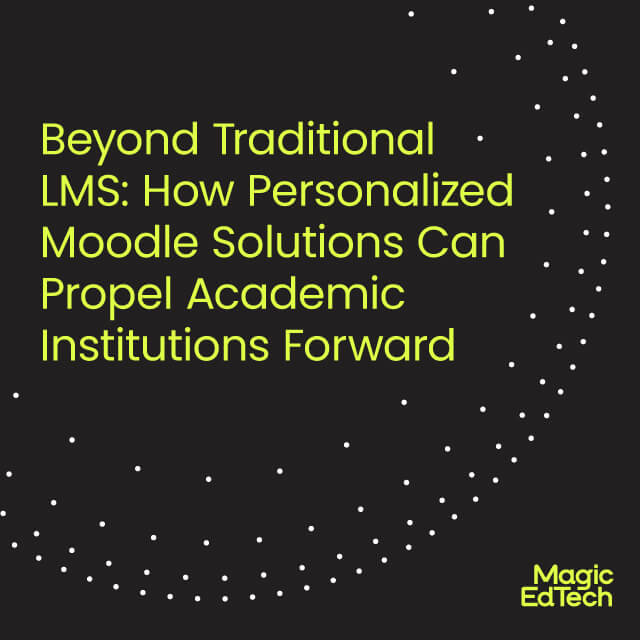Mastering the Art of Classroom Management with Moodle
- 11 August, 2023
- Reading Time: 5 mins
Classroom management is crucial to effective teaching and directly impacts students’ learning experiences. Teachers always look for innovative ways to manage their classrooms efficiently but need help overcoming roadblocks.
However, with the advancements in technology, educators now have access to powerful tools that can streamline administrative tasks and enhance student tracking. Moodle is a robust learning management system that transforms classroom management by simplifying student tracking and creating a more engaging learning experience.
But before discussing what Moodle is and how it can change the classroom management game, let’s find out how classroom management has changed over the years.
Classroom Management: Then vs. Now
Classroom management has changed significantly over the years. It is evident by the changes in educational philosophies, technological advancements, and the recognition of the diverse needs of students.
A comparison of classroom management practices from the past to the present reveals a transformation in teaching approaches and a shift towards more inclusive and student-centered learning environments.
Classroom Management: Then
- Authoritarian Approach: In the past, classroom management often followed an authoritarian approach, where the teacher held absolute authority, and students were expected to comply without question. Teachers maintained strict discipline through rigid rules and punitive measures. Students were expected to be passive listeners, and active participation was limited.
- One-Size-Fits-All Teaching: Traditional classroom management typically employs a one-size-fits-all teaching style. Lessons were designed for the average student, leaving little room for accommodating diverse learning styles or individual needs. This approach left some students disengaged and needing help to keep up with the pace of instruction.
- Lecture-Driven Instruction: Lecture-based instruction was the norm, with teachers delivering content through extended lectures. The focus was on teacher-centered instruction, and students had limited hands-on learning and interaction opportunities.
- Discipline through Punishment: Discipline in the past often relied on punishment to enforce compliance. Detentions, suspensions, and corporal punishment were standard methods to maintain classroom order.
- Limited Use of Technology: Technology should have been integrated into classroom management practices in the past. Teachers primarily relied on traditional teaching aids, such as chalkboards and textbooks, limiting the use of multimedia and interactive resources.

Classroom Management: Now
- Student-Centered Approach: Modern classroom management emphasizes a student-centered approach, where students actively participate in their learning journey. Teachers encourage critical thinking, collaboration, and student agency, fostering a more inclusive and engaging learning environment.
- Differentiated Instruction: Today’s classroom management recognizes the diversity of student needs and abilities. Differentiated instruction is utilized to tailor teaching methods to accommodate various learning styles and individual learning paces.
- Active Learning Strategies: Now, classroom management incorporates active learning strategies like group work, hands-on activities, and project-based learning. These methods promote student engagement and a deeper understanding of the subject matter.
- Positive Behavior Support: Rather than relying on punitive measures, modern classroom management often employs positive behavior support. Teachers use positive reinforcement and incentives to encourage desired behaviors and create a positive classroom culture.
- Technology Integration: Technology plays a central role in contemporary classroom management. Teachers leverage digital tools, interactive whiteboards, educational apps, and online resources to enhance teaching and learning experiences.
- Inclusive Practices: Inclusive classroom management practices are now widely embraced, ensuring that students with disabilities or diverse backgrounds receive the necessary support and accommodations to participate fully in the learning process.
How to Simplify Student Tracking with Moodle
Moodle – an open-source Learning Management System (LMS) simplifies student tracking and offers a range of features to enhance the teaching and learning experience. Let’s dive into the details.
What is Moodle?
Moodle stands for Modular Object-Oriented Dynamic Learning Environment. Developed in 2002 by Martin Dougiamas, Moodle has gained widespread popularity among educators globally due to its user-friendly interface and robust functionality.
Moodle serves as a virtual classroom that enables educators to:
- Create and manage courses
- Organize content
- Interact with students
The best part is that all this is done within a centralized platform. Its open-source nature allows for customization and integration with other educational software, making it a flexible and scalable solution for institutions of all sizes.
Advantages of Using Moodle for Student Tracking
Here are a few advantages of using Moodle for classroom management and ensuring that each student receives the support they need to reach their full potential.
Centralized Course Management
With Moodle, educators can bid farewell to the days of juggling multiple platforms for course management. Moodle offers a centralized hub where teachers can easily create, organize, and share course materials.
From lecture notes and multimedia presentations to assignments and quizzes, all the course content resides in one place, making it readily accessible to students anytime, anywhere.
Effortless Assignment Management
Gone are the days of collecting piles of paper assignments and manually tracking submissions. Moodle’s assignment module streamlines the process by allowing teachers to create digital assignments and set deadlines within the platform.
Students can then submit their work electronically, eliminating the need for physical hand-ins. Furthermore, teachers can provide timely feedback and grades directly through Moodle, fostering a more efficient and transparent grading process.
Real-time Student Progress Monitoring
Moodle gives educators real-time insights into students’ progress and engagement with course materials. Teachers can view students’ quiz scores, participation in discussions, and completion of assignments, giving them a comprehensive overview of each student’s learning journey.
This data-driven approach allows teachers to identify struggling students early on and provide targeted support to ensure academic success.
Customizable Reports for Informed Decision-Making
Educational institutions often require data to make informed decisions about curriculum planning, student performance, and resource allocation. Moodle offers customizable reporting tools that enable teachers and administrators to generate detailed reports on student progress, engagement, and performance.
These reports provide valuable insights that facilitate data-driven decision-making to enhance the learning experience.
Interactive Learning Activities for Increased Engagement
Moodle offers a wide range of interactive learning activities beyond traditional teaching methods. Teachers can create engaging quizzes, discussion forums, and collaborative group projects to increase active participation among students.
This interactivity boosts student engagement and nurtures critical thinking and communication skills.
Gamification Elements to Motivate Students
Moodle allows for integrating gamification elements to make the learning experience more enjoyable and motivating. Teachers can award badges and set up leaderboards to recognize students’ achievements and encourage healthy competition.
Gamification enhances student motivation and instills a sense of accomplishment, driving them to excel academically.
Final Thoughts
Moodle enhances classroom management to the next level by providing teachers with a powerful and user-friendly platform to simplify student tracking and improve engagement.
As technology advances, educators can harness the potential of tools like Moodle to create a dynamic and inclusive learning environment that nurtures student success.
Need a trusted partner for seamless Moodle integration? Magic EdTech can help you integrate Moodle into your tech stack seamlessly and has a proven track record in educational technology.
As your trusted Moodle integration partner, Magic Ed Tech helps you access cutting-edge tools to transform classroom management and simplify student tracking. Our user-friendly platform ensures a smooth integration process, allowing you to harness the full potential of Moodle without any hassle.
Schedule a call with us today and let our team of experts guide you through the integration process that will enhance your institution’s educational experience.




